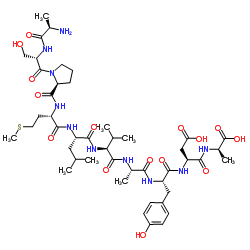1447799-33-8
| Name | Reltecimod |
|---|---|
| Synonyms |
UNII:U00J02UY29
D-Alanyl-L-seryl-L-prolyl-L-methionyl-L-leucyl-L-valyl-L-alanyl-L-tyrosyl-L-α-aspartyl-D-alanine D-Alanine, D-alanyl-L-seryl-L-prolyl-L-methionyl-L-leucyl-L-valyl-L-alanyl-L-tyrosyl-L-α-aspartyl- Reltecimod U00J02UY29 10377 |
| Description | Reltecimod (AB-103) is a T-cell-specific surface glycoprotein CD28 (TP44) antagonist. Reltecimod has beneficial effects against different bacterial infections, their exotoxins and endotoxins, and ionizing radiation. Reltecimod modulates the inflammatory response by targeting and attenuating the critical CD28/B7-2 co-stimulatory pathway, without inhibiting it. Reltecimod can be used to research necrotizing soft-tissue infections (NSTIs)[1][2]. |
|---|---|
| Related Catalog | |
| Target |
TP44, Bacteria[1][2] |
| In Vivo | Reltecimod (1.25-5 mg/kg; i.v.) increases the survival rate of mice infected with different bacteria[2]. Animal Model: Pathogen-free, female BALB/c mice (Acute bacterial peritonitis was induced by i.p. administration with E. coli 018:K1)[2] Dosage: 1.25 or 5 mg/kg Administration: i.v.; single dosage; at 4 h post infection Result: Resulted in 100% survival at single dosage of 5 mg/kg, at day 6. Resulted in 70% survival at 4 dosage (at 1, 12, 24 and 36 h post infection) of 1.25 mg/kg, at day 6. Animal Model: Pathogen-free, female BALB/c mice (NSTI induced by thigh i.m. administration with Streptococcus pyogenes)[2] Dosage: 2.5 or 5 mg/kg Administration: i.v.; single dosage; at 1 h, or at 1 h and 12 or 72 h post infection Result: Resulted in 65% survival at single dosage of 2.5 mg/kg, at day 8. Resulted in 30% survival at two dosage (1 and 12 h post infection) of 2.5 mg/kg, at day 8. Resulted in 90% survival at single dosage (1 h post infection) of 5 mg/kg, at day 6. Animal Model: Pathogen-free, female BALB/c mice [Cecal ligation and puncture (CLP) model][2] Dosage: 1.25, 2.5, or 5 mg/kg Administration: i.v.; single dosage Result: Increased day 7 survival by up to 100%. |
| References |
| Density | 1.3±0.1 g/cm3 |
|---|---|
| Boiling Point | 1473.8±65.0 °C at 760 mmHg |
| Molecular Formula | C46H72N10O15S |
| Molecular Weight | 1037.187 |
| Flash Point | 845.1±34.3 °C |
| Exact Mass | 1036.489990 |
| LogP | 1.38 |
| Vapour Pressure | 0.0±0.3 mmHg at 25°C |
| Index of Refraction | 1.573 |

